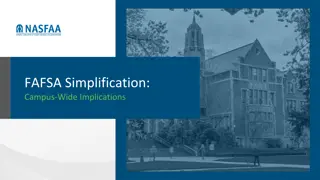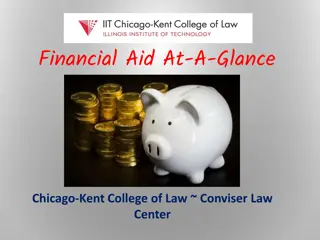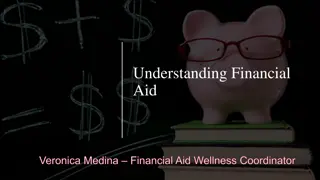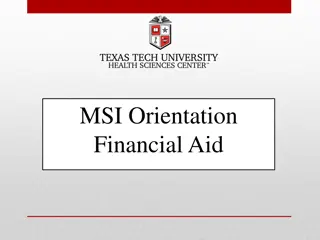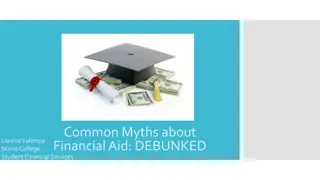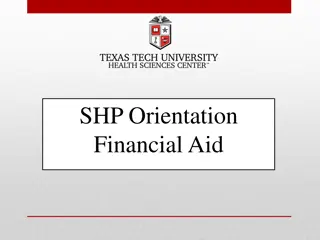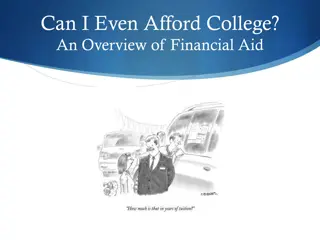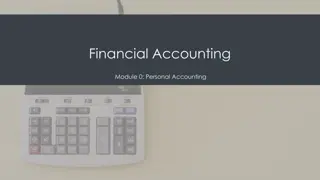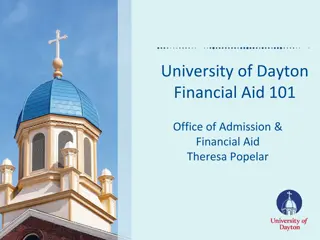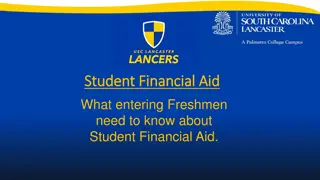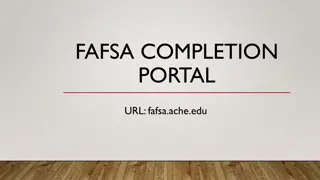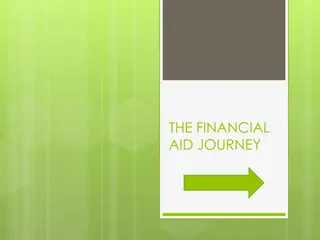
Financial Aid for College: A Comprehensive Guide
Explore the world of financial aid for college, covering topics like what financial aid is, where to find it, how to apply, and who can assist you. Learn about different types of financial aid, college costs, the FAFSA application process, and more to navigate your financial future successfully.
Download Presentation

Please find below an Image/Link to download the presentation.
The content on the website is provided AS IS for your information and personal use only. It may not be sold, licensed, or shared on other websites without obtaining consent from the author. If you encounter any issues during the download, it is possible that the publisher has removed the file from their server.
You are allowed to download the files provided on this website for personal or commercial use, subject to the condition that they are used lawfully. All files are the property of their respective owners.
The content on the website is provided AS IS for your information and personal use only. It may not be sold, licensed, or shared on other websites without obtaining consent from the author.
E N D
Presentation Transcript
Financial Aid Overview Melbourne High School October 12, 2021 Guidance Department
Navigating Your Financial Future Agenda What is financial aid? Where do I find financial aid? How and When do I apply? Who can help me?
What is Financial Aid? Monies received from Four Sources: Federal, State, Institutional or Private Monies are also categorized as: Gift aid (Free $$$$ grants, scholarships) Self-help (student loans and work study) Need-based (grants, scholarships, work- study and loans) Merit-based ($$ awarded on academics, athletics, artistic or special interest) Can cover direct or indirect costs
College Costs COA=Cost of Attendance varies from: Institution to institution In State vs. out of state On campus vs. off campus Net Price Calculator Requirement for every institution Allows prospective students to enter information about themselves and find out what students like them paid to attend that college the previous year
College Costs Public 2-year college (tuition and fees, in- state) - $3,770 Public 4-year college (tuition and fees, in- state) - $10,560 (meal plan $4,000) Public 4-year college (tuition and fees, out of state) - $27,020 (low end not including food) Private 4-year college (tuition and fees) - $37,650 (low end not including food) Source: The College Board
Free Application for Federal Student Aid (FAFSA) Federal government is largest source of student aid; FAFSA distributed and processed by the U.S. Department of Education Manual or electronic options 2022-23 FAFSA opened October 1 IRS Data Retrieval Tool opened October 1 and will allow students to import PRIOR PRIOR (2020) year tax data Must be completed ANNUALLY (per academic year) to be evaluated for financial aid www.fafsa.gov
What type of form is FAFSA? This is the form colleges use to determine a student s eligibility for financial aid. Financial aid comes in the form of grants, loans and work study. FAFSA does not give you money but colleges use it to see what your ability is to pay for college and how much financial aid you would need if accepted to their school.
Help FAFSA.GOV
How do you get started? Gather important data Monitor priority deadlines State and institutional deadlines vary Confirm FAFSA dependency versus independency requirements Dependent students are required to include parental information Independent students are not required to include parental information Search for school codes Plan to sign and submit online using the Federal Student Aid (FSA) ID and FSA Password
Student Dependent or Independent? Were you born before January 1, 1999? As of today are you married? At the beginning of the 2022-23 school year, will you be working on a master s or doctorate program (such as an MA, MBA, MD, JD, PhD, EdD, or graduate certificate, etc.)? Are you currently serving on active duty in the U.S. Armed Forces for purposes other than training?
Student Dependent or Independent? At any time since you turned age 13, were both your parents deceased, were you in foster care or were you a dependent or ward of the court?
Student Dependent or Independent? As determined by a court in your state of legal residence, are you or were you an emancipated minor? Does someone other than your parent or stepparent have legal guardianship of you, as determined by a court in your state of legal residence? At any time on or after July 1, 2021, did your high school or school district homeless liaison determine that you were an unaccompanied youth who was homeless or were self- supporting and at risk of being homeless?
Who is a Parent? A legal parent includes a biological or adoptive parent, or a person that the state has determined to be your parent (for example, when a state allows another person s name to be listed as a parent on a birth certificate). Grandparents, foster parents, legal guardians, older brothers or sisters, widowed stepparents, and aunts and uncles are not considered parents unless they have legally adopted you.
Parent Marital Status Never Married Unmarried but living together Married Remarried Divorced or separated Widowed
Student Aid Report (SAR) Provides basic information about federal student aid eligibility Received (after you submit the FAFSA) via email within 3-5 days if you provided an email address Received via mail within 7-10 days if you did not provide an email address Correct errors, if needed Will contain an expected family contribution (EFC) Assists institutions in the financial aid award packaging process COA (Cost of Attendance)-EFC=Financial need
Additional Information Contact institution to determine award disbursement process Contact institution for special circumstances or professional judgment needs Contact institution to determine what other types of aid applications are available Use student loans as a LAST RESORT
Additional Information Verification Process Financial Aid Award Notification Communication with the Post Secondary Institution Formula: Cost of Attending Expected Family Contribution = Financial Need Scholarships/Grants (Institutional/Federal/State) Florida Prepaid-529 Plans (Check with your Institution) Federal Loans: Student/Parent Subsidized (USDOE pays interest in school) Unsubsidized (Student responsible interest) Subsidized/Unsubsidized (Principal + interest begins after graduation or not enrolled for 6 months) Private Loans
Mapping Your Future (MYF) www.mappingyourfuture.org Mapping Your Future is a non-profit organization dedicated to combining person-to-person financial counseling with online resources to help students plan for their future with: College preparation School selection Career exploration Money management www.mappingyourfuture.org
Navigating your Financial Future (NyFF) www.navigatingyourfuture.org Financing higher education Managing day-to-day money Career planning School/Life management Resources available at no cost www.navigatingyourfuture.org
Office of Student Financial Assistance (OSFA) Contacts Email: osfa@fldoe.org Telephone: 1-888-827-2004 OSFA Director Outreach Services: Pete Hernandez | 850.245.1821 | Pedro.Hernandez@fldoe.org


